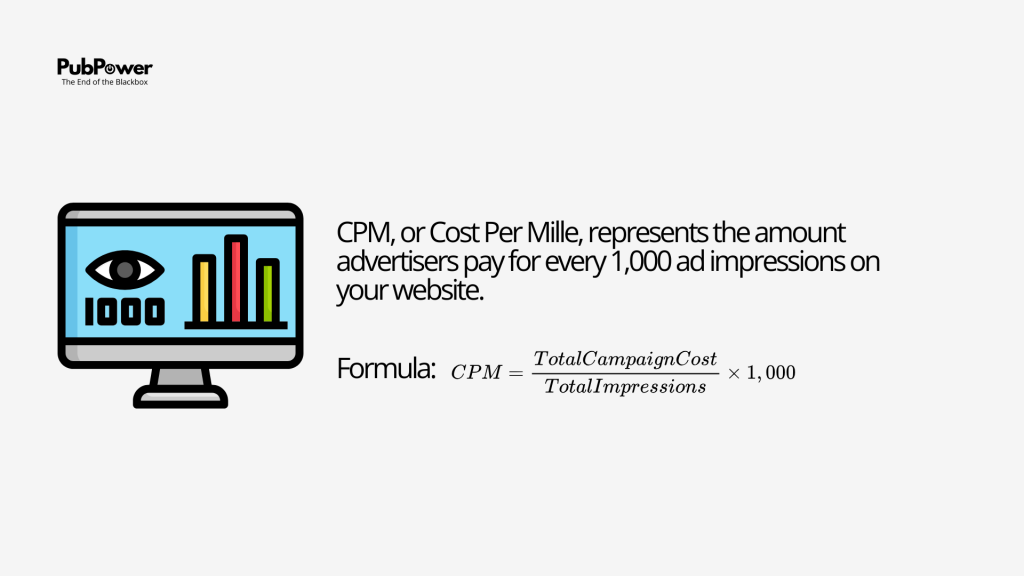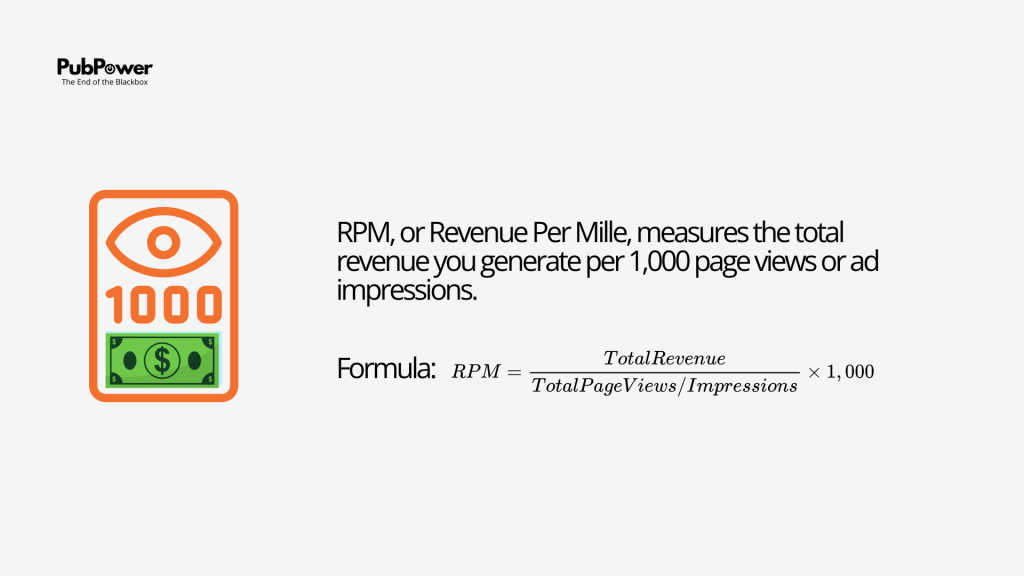Understanding the nuances between CPM and RPM isn’t just about knowing definitions—it’s about unlocking the full revenue potential of your website. As digital advertising becomes increasingly complex, these metrics serve as your compass for navigating the monetization landscape effectively.
Whether you’re a seasoned publisher or just starting your monetization journey, mastering both CPM and RPM will transform how you approach ad strategy, pricing negotiations, and revenue optimization.
Contents
- 1 What is CPM (Cost Per Mille)?
- 2 Types of CPM You Should Know
- 3 What is RPM (Revenue Per Mille)?
- 4 Key Differences Between CPM and RPM
- 5 Factors Influencing CPM and RPM
- 6 Factors Influencing CPM and RPM
- 7 Advanced Optimization Strategies
- 8 Tools and Platforms for Tracking
- 9 Frequently Asked Questions
- 10 Conclusion
What is CPM (Cost Per Mille)?

CPM, or Cost Per Mille, represents the amount advertisers pay for every 1,000 ad impressions on your website. The term “mille” comes from Latin, meaning thousand, making CPM literally “cost per thousand.”
This advertiser-focused metric serves as the foundation of display advertising pricing. When an advertiser sets a CPM bid of $8, they’re committing to pay $8 for every 1,000 times their ad appears on your site, regardless of whether users interact with it.
How CPM Works in Practice
CPM operates on a simple impression-based model. Every time an ad loads on your webpage—whether a user sees it for one second or scrolls past immediately—it counts as an impression. This makes CPM particularly valuable for brand awareness campaigns where visibility matters more than clicks.
Real-world example: A luxury car brand might pay a $15 CPM to display their ads on an automotive review site, knowing that reaching affluent car enthusiasts justifies the premium cost.
CPM Calculation Formula
CPM = (Total Campaign Cost ÷ Total Impressions) × 1,000Example: An advertiser spends $750 on a campaign generating 150,000 impressions. CPM = ($750 ÷ 150,000) × 1,000 = $5
Types of CPM You Should Know
The advertising ecosystem has evolved beyond basic CPM, introducing specialized variations that offer different advantages.
Effective CPM (eCPM)
eCPM measures your actual earnings per 1,000 impressions, regardless of the pricing model used. It’s particularly useful when you’re running campaigns with different bidding strategies (CPC, CPA, CPM) simultaneously.
When to use: Comparing performance across different ad networks and pricing models.
Viewable CPM (vCPM)
vCPM only counts impressions when ads are actually viewable to users—typically when at least 50% of the ad is visible for one second or more. This addresses the concern about ads loading below the fold or in non-visible areas.
Publisher benefit: Higher vCPM rates often translate to better user experience and advertiser satisfaction.
Revenue CPM (rCPM)
rCPM calculates revenue per 1,000 ad requests rather than impressions, providing insight into your ad serving efficiency and helping identify technical issues affecting monetization.
What is RPM (Revenue Per Mille)?

RPM, or Revenue Per Mille, measures the estimated revenue you generate per 1,000 page views or ad impressions. Unlike CPM, which focuses on individual ad costs, RPM provides a holistic view of your site’s monetization performance.
This publisher-centric metric aggregates all estimated revenue streams on your pages—display ads, video ads, native advertising, and any other monetization methods—giving you a comprehensive picture of your earning efficiency.
Why RPM Matters More to Publishers
RPM tells the complete story of your monetization success. While CPM shows what individual advertisers pay, RPM reveals what you can earn after considering all factors: multiple ad units, various ad networks, different bidding types, and revenue sharing arrangements.
Practical insight: Your page might have three ad units with CPMs of $4, $6, and $8, but your RPM might be $12 due to optimized placement and additional revenue sources.
RPM Calculation Formula
RPM = (Total Revenue ÷ Total Page Views/Impressions) × 1,000Example: Your site generates $1,200 from 200,000 page views. RPM = ($1,200 ÷ 200,000) × 1,000 = $6
Key Differences Between CPM and RPM
Understanding these differences helps publishers make strategic decisions about ad placement, pricing, and optimization efforts.
| Aspect | CPM | RPM |
| Perspective | Advertiser-focused | Publisher-focused |
| Measurement | Cost per 1,000 impressions | Revenue per 1,000 impressions/views |
| Scope | Individual ad campaigns | Total page monetization |
| Primary Use | Setting ad prices, comparing networks | Measuring overall performance |
| Calculation Base | Campaign costs | All revenue sources |
| Optimization Focus | Ad quality and targeting | Overall page profitability |
Perspective and Purpose
CPM serves advertisers who need to budget and compare advertising costs across different platforms. Publishers use CPM to understand market rates and negotiate better deals with advertisers.
RPM, conversely, helps publishers evaluate their monetization strategy’s effectiveness. It answers the critical question: “How much am I actually earning from my traffic?”
Measurement Scope
While CPM examines individual ad performance in isolation, RPM considers the cumulative effect of all monetization elements on a page. This broader perspective makes RPM more valuable for strategic decision-making.
Factors Influencing CPM and RPM
Multiple variables affect these metrics, and understanding them enables strategic optimization.
Audience Quality and Demographics
Premium audiences command higher CPMs. Factors that increase advertiser willingness to pay include:
- Income levels: Higher-income audiences attract luxury and premium service advertisers
- Education: Well-educated audiences often correlate with higher purchasing power
- Professional demographics: B2B advertisers pay premiums to reach decision-makers
- Geographic location: Developed markets typically offer higher rates
Content Quality and Relevance
Search engines and advertisers favor high-quality, relevant content. Pages with:
- Expert authorship and authoritative sources
- Regular updates and fresh information
- User engagement metrics (time on page, low bounce rates)
- Niche expertise often achieve higher monetization rates
Technical Performance Factors
Improve CLS (Cumulative Layout Shift) to boost user experience and ad performance. Key technical factors include:
- Page loading speed: Faster pages improve ad viewability
- Mobile optimization: Mobile-first indexing makes responsive design crucial
- Ad placement: Strategic positioning balances user experience with revenue
- Site architecture: Clean, intuitive navigation improves user engagement
Factors Influencing CPM and RPM
Multiple variables affect these metrics, and understanding them enables strategic optimization.
Audience Quality and Demographics
Premium audiences command higher CPMs. Factors that increase advertiser willingness to pay include:
- Income levels: Higher-income audiences attract luxury and premium service advertisers
- Education: Well-educated audiences often correlate with higher purchasing power
- Professional demographics: B2B advertisers pay premiums to reach decision-makers
- Geographic location: Developed markets typically offer higher rates
Content Quality and Relevance
Search engines and advertisers favor high-quality, relevant content. Pages with:
- Expert authorship and authoritative sources
- Regular updates and fresh information
- User engagement metrics (time on page, low bounce rates)
- Niche expertise often achieve higher monetization rates
Technical Performance Factors
Improve CLS (Cumulative Layout Shift) to boost user experience and ad performance. Key technical factors include:
- Page loading speed: Faster pages improve ad viewability
- Mobile optimization: Mobile-first indexing makes responsive design crucial
- Ad placement: Strategic positioning balances user experience with revenue
- Site architecture: Clean, intuitive navigation improves user engagement
Advanced Optimization Strategies
Maximizing both CPM and RPM requires sophisticated approaches that go beyond basic ad placement.
CPM Optimization Techniques
1. Audience Segmentation and Targeting
Create detailed audience personas to attract premium advertisers. Use analytics to identify your most valuable visitor segments and tailor content to attract similar users.
2. Premium Ad Formats
Experiment with high-value ad formats:
- Video advertising: Often commands 3-5x higher CPMs than display
- Native advertising: Integrates naturally with content, improving user experience
- Rich media ads: Interactive elements can justify premium pricing
3. Seasonal and Trending Content
Capitalize on high-demand periods when advertisers increase spending. Create content around:
- Holiday seasons (Black Friday, Christmas, Valentine’s Day)
- Industry events and conferences
- Trending topics in your niche
RPM Enhancement Strategies
1. Multi-Network Optimization
Don’t rely on a single ad network. Implement header bidding or use multiple networks to create competition for your ad inventory. This typically increases RPM by 15-30%.
2. Ad Density Optimization
Find the sweet spot between ad revenue and user experience. Use multiple ad units in strategic locations while maintaining readability and engagement.
3. Content Performance Analysis
Identify your highest-performing content and create more similar pieces. Use tools like Google Analytics to understand which pages generate the best RPM and replicate those success factors.
Tools and Platforms for Tracking
Effective measurement requires the right tools. Here’s what successful publishers use:
Google Ad Manager (GAM)
The industry standard for large publishers, offering:
- Advanced reporting with custom dimensions
- Header bidding integration
- Audience segmentation capabilities
- Real-time optimization tools
Google Analytics 4
Essential for understanding user behavior and its impact on monetization:
- Audience insights for targeting optimization
- Content performance metrics
- Conversion tracking for holistic revenue analysis
- Custom reporting for CPM/RPM analysis
Third-Party Analytics Platforms
Specialized tools like PubPower, and others offer:
- Advanced optimization algorithms
- A/B testing for ad placements
- Competitive analysis
Frequently Asked Questions
What’s a good CPM rate for new publishers?
New publishers typically see CPMs between $1-5, depending on their niche and audience quality. Focus on building high-quality content and engaged audiences rather than chasing high CPMs immediately.
How often should I check my RPM?
Monitor RPM daily for trends but make optimization decisions based on weekly or monthly data to avoid reacting to normal fluctuations.
Can I have high CPM but low RPM?
Yes, this might indicate issues with ad serving, low fill rates, or technical problems preventing ads from displaying properly. It could also suggest you need to optimize ad density or placement.
Which metric should I prioritize as a publisher?
While both are important, RPM provides a more comprehensive view of your monetization success. Use CPM to understand market rates and negotiate better deals, but optimize primarily for RPM growth.
How do mobile vs desktop CPMs compare?
Mobile CPMs are typically 20-40% lower than desktop due to smaller screen sizes and user behavior differences. However, mobile traffic volume often compensates for lower rates.
What factors immediately impact my CPM rates?
The most immediate factors include audience geography, content quality, page loading speed, and ad viewability. Seasonal trends and advertiser budgets also create short-term fluctuations.
Conclusion
Start by establishing baseline measurements for both metrics across your top-performing pages. Implement one optimization strategy at a time, measure results over at least two weeks, then adjust based on performance data.
Remember that sustainable revenue growth comes from balancing advertiser value with user experience. Focus on creating content that attracts premium audiences while maintaining the technical excellence that keeps both users and advertisers satisfied.
The advertising landscape will continue evolving, but publishers who master these fundamental metrics while staying adaptable to new trends will consistently outperform their competition.
Want to optimize your ad revenue with expert guidance? PubPower.io specializes in helping publishers maximize their CPM and RPM through data-driven strategies and cutting-edge optimization techniques. Contact our team to discover how we can boost your website’s earning potential.



